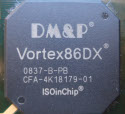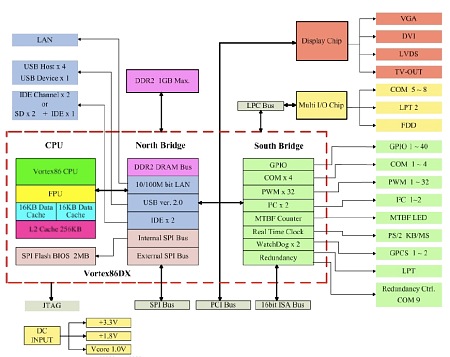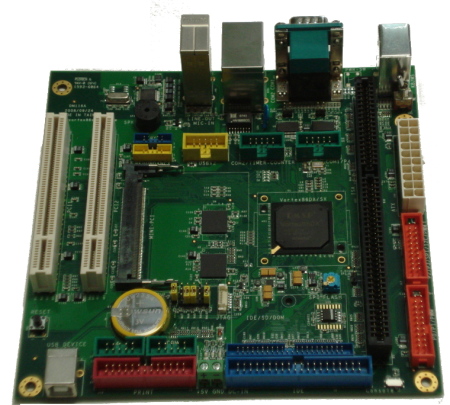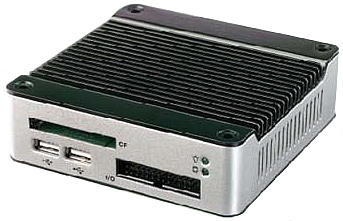Die-shrunk x86 SoC draws 2 Watts at 1GHz
Nov 20, 2008 — by LinuxDevices Staff — from the LinuxDevices Archive — 84 views DMP Electronics announced a 32-bit x86-compatible SoC (system on chip) claimed to run Linux using under two Watts. The Vortex86DX targets home gateways, thin clients, and industrial controllers, and offers an “embedded redundancy” feature that can link two boards, says DMP.
DMP Electronics announced a 32-bit x86-compatible SoC (system on chip) claimed to run Linux using under two Watts. The Vortex86DX targets home gateways, thin clients, and industrial controllers, and offers an “embedded redundancy” feature that can link two boards, says DMP.
(Click here for a larger view of the Vortex86DX)Vortex86SX SoC, and retains that product's 27 x 27mm package. However, DMP has transitioned from a .13 Micron process to 90nm, enabling a variety of enhancements.
Most notably, while the Vortex86SX was said to use under one Watt at 300MHz, the Vortex86DX uses under two Watts while being clocked at up to 1GHz, claims DMP. In addition, the SoC now not only includes the complete 486SX instruction set, but also adds floating point support and other enhancements, according to the company.
In addition to the higher clock speed and floating point support, other performance enhancements in the new SoC are said to include:
- 256KB of embedded L2 cache (compared to none on the Vortex86SX)
- Support for up to 1GB of 333MHz DDR2 RAM (compared to the Vortex86SX's 256MB of 166MHz DDR RAM)
- A 2MB flash BIOS (compared to the Vortex86SX's 256KB BIOS)
Apart from these improvements, the Vortex86DX also retains an interesting “embedded redundancy” feature that first made its debut on DMP's earlier SoC. DMP says the feature allows two Vortex86DX CPU boards to be linked via a single cable in a master/slave configuration. In the event of “six different types of unpredictable system crash” — which were not detailed further — it's possible to switch from the master board to the slave board within one microsecond, the company claims.

A block diagram of the Vortex86DX
(Click to enlarge)
In addition to its 32-bit, x86-compatible CPU, the Vortex86DX packs extensive northbridge and southbridge functions. On-chip controllers include serial, parallel, USB, GPIO (general purpose I/O lines), watchdog timer, counter, and a 10/100Mbps Ethernet controller — see block diagram, above.

DMP's VDX-6390
(Click to enlarge)
DMP supplied the above photograph of its VDX-6390, a board designed to accept the Vortex86DX. Though no details were provided, this board looks similar to the company's earlier VSX-6190, which was designed for the Vortex86SX. The VDX-6390 apparently includes PCI and ISA expansion slots, a Mini PCI slot, multiple serial ports, USB ports, IDE, a parallel port, and audio I/O.
Background
The previous Vortex86SX was sold by DMP as part of a complete computer, the eBox-2300SX shown below. Capable of running Linux or Windows CE, this device sold for under $85, with 128MB of DDR RAM, three USB 2.0 ports, one Type I/II CompactFlash slot, and a 10/100Mbps Ethernet LAN port.

DMP's eBox-2300SX system incorporated the Vortex86SX processor
 Ebox-4300 |
At the end of 2007, DMP announced an upgraded version, the eBox-4300. While retaining the eBOX-2300SX's dimensions of 4.5 x 4.5 x 1.4 inches and weight of 18 ounces, this device employed Via's 500MHz Eden ULV and CX700M northbridge/southbridge.
Now, thanks to the Vortex86DX, DMP apparently has the technology to retool, creating a Linux- and XP-capable PC it can call its own. Competition could grow in the low-power x86-compatible SoC space, with Intel taking an increasing interest in low-power, highly integrated chips. Its Tolapai part, targeting mainly storage applications, integrates a Pentium M core with typical northbridge and southbridge functions, for example.
In July, Tri-M Engineering shipped the latest version of its Vortex86SX-equipped PC/104-Plus processor module called the VSX104+. The module is said to support both Linux and Windows CE, and is aimed at industrial computing and data collection applications.
Further information
According to DMP Electronics, the Vortex86DX is compatible with Linux, Windows XP Embedded, Windows XP, and “most popular 32-bit real-time operating systems.” Pricing and availability were not announced.
This article was originally published on LinuxDevices.com and has been donated to the open source community by QuinStreet Inc. Please visit LinuxToday.com for up-to-date news and articles about Linux and open source.